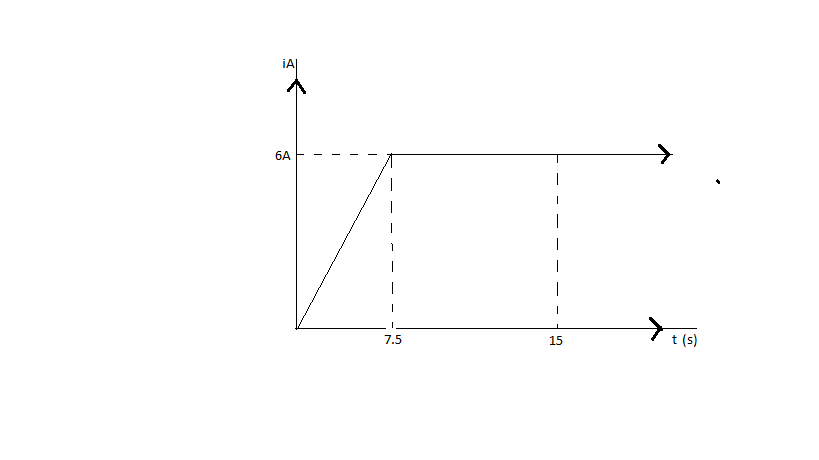
The graph of current versus time in a wire is given by

If charge flows through the wire in $7.5s$ is ${q_1}$ and that flows through the wire in $15s$ is ${q_2}$, then ratio ${q_1}:{q_2}$ is
A. $2:1$
B. $1:2$
C. $4:1$
D. $1:4$
E. $1:3$
Answer
217.8k+ views
Hint: From the graph it is evident that the current remains the same in both the time stamps. So we can just use the current formula to calculate the charges in both the cases and then divide them to obtain the ratio.
Formulas used
$i = \dfrac{q}{t}$ where $i$ is the current flowing through the conductor, $q$ is the charge and $t$ is the time taken.
Complete step by step answer
Electric current is defined as the flow of electric charge (electrons) per unit time through a conducting medium. Its SI unit is Ampere and is symbolized by $A$. It is measured using a device called the ammeter.
The flow of electric current is due to the stream of charged particles such as electrons from a region of higher potential to a region of lower potential. This means that current can only flow through a medium when there is a potential difference present.
Now, we can solve the question given by using the definition of current which gives us the relation,
$i = \dfrac{q}{t}$ where $i$ is the current flowing through the conductor, $q$ is the charge and $t$ is the time taken.
On the graph given above we see that the value of current is constant from time $t = 7.5s$to $15s$ and beyond.
So, using the current equation we can write,
${q_1} = 6 \times 7.5$$C$ where ${q_1}$is the charge at $t = 7.5s$
Similarly,
${q_2} = 6 \times 15C$ where ${q_2}$ is the charge at $t = 15s$
Dividing these two equations we get,
$\dfrac{{{q_1}}}{{{q_2}}} = \dfrac{{6 \times 7.5}}{{6 \times 15}}$
$ \Rightarrow \dfrac{{{q_1}}}{{{q_2}}} = \dfrac{1}{2}$
${q_1}:{q_2} = 1:2$
Therefore, the correct option is B.
Note: In a conductor, the total current is due to the flow of electrons which are negative charge carriers. However, in case of semiconductors, the flow of current is due to both positive and negative carriers. Unlike conductors, semiconductors can only conduct electricity at very high temperatures. This is due to the fact that semiconductors have a negative coefficient of resistance with temperature. Which means that their resistance decreases with increase in temperature.
Formulas used
$i = \dfrac{q}{t}$ where $i$ is the current flowing through the conductor, $q$ is the charge and $t$ is the time taken.
Complete step by step answer
Electric current is defined as the flow of electric charge (electrons) per unit time through a conducting medium. Its SI unit is Ampere and is symbolized by $A$. It is measured using a device called the ammeter.
The flow of electric current is due to the stream of charged particles such as electrons from a region of higher potential to a region of lower potential. This means that current can only flow through a medium when there is a potential difference present.
Now, we can solve the question given by using the definition of current which gives us the relation,
$i = \dfrac{q}{t}$ where $i$ is the current flowing through the conductor, $q$ is the charge and $t$ is the time taken.
On the graph given above we see that the value of current is constant from time $t = 7.5s$to $15s$ and beyond.
So, using the current equation we can write,
${q_1} = 6 \times 7.5$$C$ where ${q_1}$is the charge at $t = 7.5s$
Similarly,
${q_2} = 6 \times 15C$ where ${q_2}$ is the charge at $t = 15s$
Dividing these two equations we get,
$\dfrac{{{q_1}}}{{{q_2}}} = \dfrac{{6 \times 7.5}}{{6 \times 15}}$
$ \Rightarrow \dfrac{{{q_1}}}{{{q_2}}} = \dfrac{1}{2}$
${q_1}:{q_2} = 1:2$
Therefore, the correct option is B.
Note: In a conductor, the total current is due to the flow of electrons which are negative charge carriers. However, in case of semiconductors, the flow of current is due to both positive and negative carriers. Unlike conductors, semiconductors can only conduct electricity at very high temperatures. This is due to the fact that semiconductors have a negative coefficient of resistance with temperature. Which means that their resistance decreases with increase in temperature.
Recently Updated Pages
Arithmetic, Geometric & Harmonic Progressions Explained

Cartesian Form of Vector Explained: Formula, Examples & Uses

Apparent Frequency Explained: Formula, Uses & Examples

Calorimetry: Definition, Principles & Calculations

Centrifugal Force Explained: Definition, Formula & Examples

Charge in a Magnetic Field: Definition, Formula & Examples

Trending doubts
JEE Main 2026: Application Form Open, Exam Dates, Syllabus, Eligibility & Question Papers

Derivation of Equation of Trajectory Explained for Students

Hybridisation in Chemistry – Concept, Types & Applications

Understanding the Angle of Deviation in a Prism

Understanding Collisions: Types and Examples for Students

Understanding Atomic Structure for Beginners

Other Pages
JEE Advanced Marks vs Ranks 2025: Understanding Category-wise Qualifying Marks and Previous Year Cut-offs

How to Convert a Galvanometer into an Ammeter or Voltmeter

Ideal and Non-Ideal Solutions Explained for Class 12 Chemistry

Degree of Dissociation: Meaning, Formula, Calculation & Uses

Understanding Electromagnetic Waves and Their Importance

Understanding Average and RMS Value in Electrical Circuits




